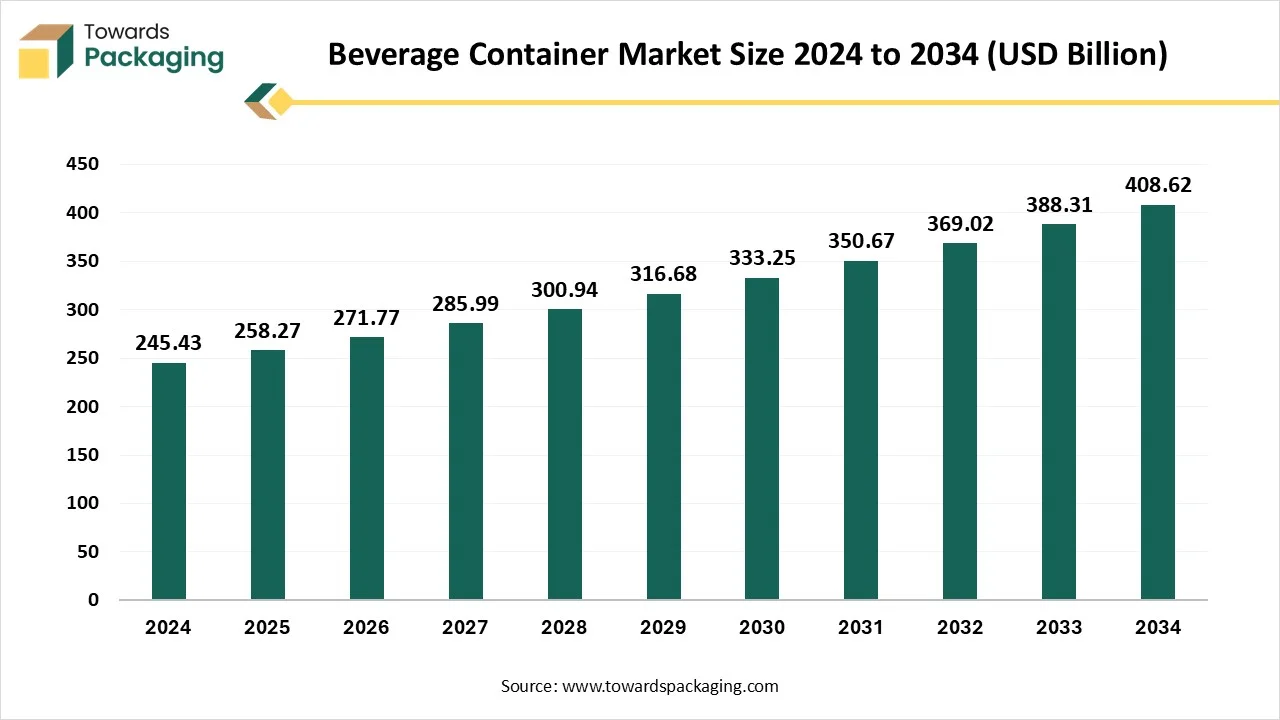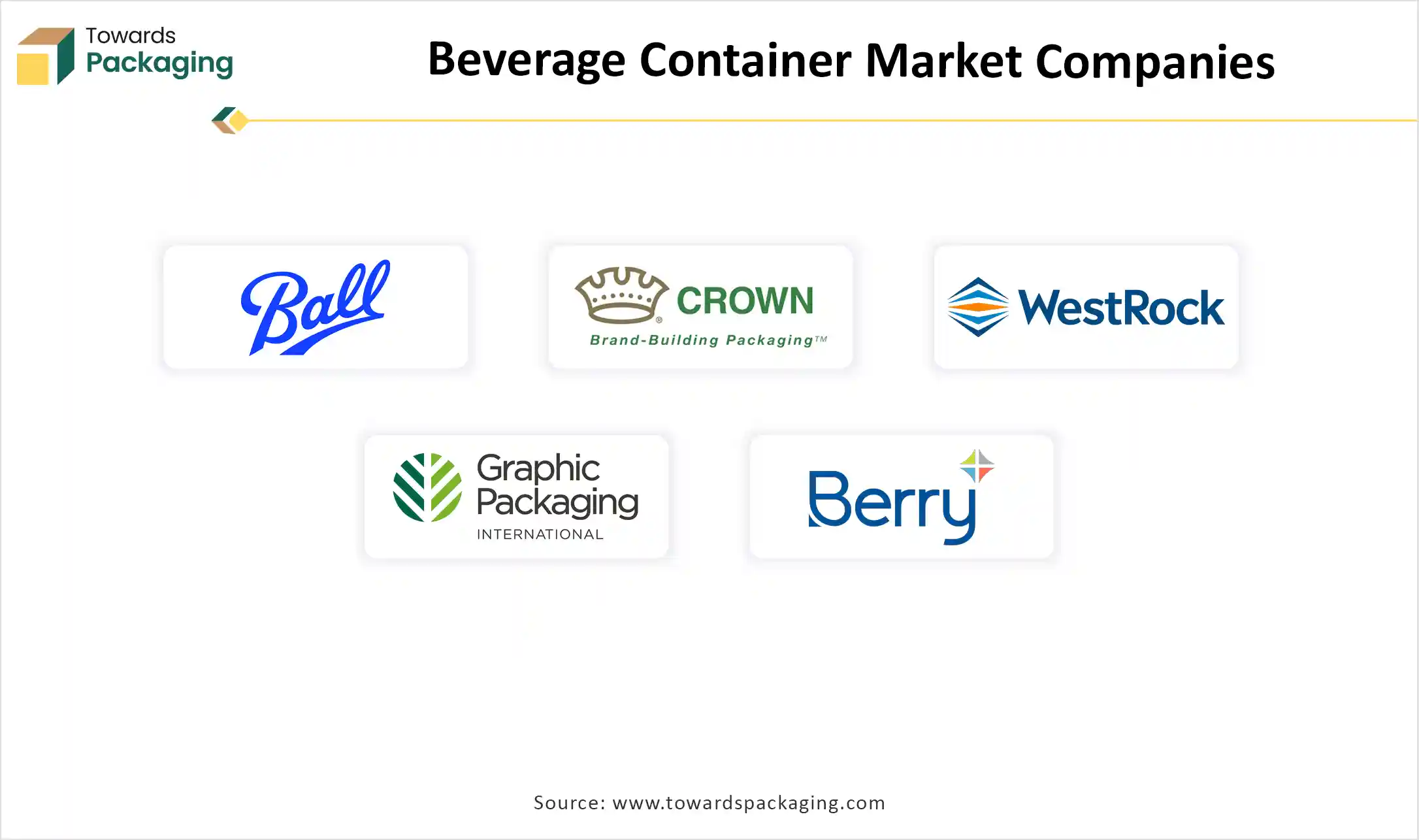November 2025
The beverage container market is expanding steadily, growing from USD 258.27 billion in 2025 to USD 408.62 billion by 2034, supported by a 5.23% CAGR. This report covers market size, emerging trends, capacity-based segmentation, material analysis, and application insights, along with a deep breakdown across North America, Europe, Asia Pacific, Latin America, and MEA. It also evaluates major companies such as Ball Corporation, Crown Cork & Seal, WestRock, Berry Global, and Ardagh, and includes competitive analysis, global trade flows, manufacturing landscape, and a complete value chain assessment.

The beverage container market is growing significantly due to the rising demand for beverages due to various factors. A beverage container is a dedicated vessel considered for the transportation and storage of several drinks, comprising alcoholic beverages, soft drinks, water, juices, and more. These vessels come in several varieties of resources, sizes, and shapes, each personalized to exact beverage categories and consumption choices. Common resources for beverage containers consisting of stainless steel, plastic, glass, and aluminum with each contributing exclusive benefits such as temperature retention, portability, and durability.
The functionality and design of such beverage containers have changed over the years, integrating features such as eco-friendly, insulation, and resealable caps resources to provide changes to customer demands and ecological concerns. Beverage containers play a crucial role in conserving the quality and freshness of beverages and confirming suitability and availability for customers across the world.
| Metric | Details |
| Market Size in 2024 | USD 245.43 Billion |
| Projected Market Size in 2034 | USD 408.62 Billion |
| CAGR (2025 - 2034) | 5.23% |
| Leading Region | Asia Pacific |
| Market Segmentation | By Material, By Capacity, By Application and By Region Covered |
| Top Key Players | Ball Corporation, Crown Cork & Seal Co, WestRock, Graphic Packaging International, Ardagh Metal Packaging, Berry Global |
In the beverage container market, there is a huge impact of AI in both formulation as well as packaging of beverages. Artificial intelligence system has evolved the inspection process of the packaging industry which ensure error-free packaging and enhance the reliability of the brands. It helps to customize the beverages packaging such as adding QR codes, specific messages, or unique patterns to enhance the visibility of the packaging. It ensures the digital specification, improving the prints on the packaging, and maintain the detailing in personalized packaging even in bulk production.
Predictive maintenance arrangements analyze the gathered data from sensors on the system, recognizing potential problems prior to any disruptions. It enhanced the sustainability of the packaging as it has become a major priority of the consumers. The incorporation of advanced technology like AI can calculate the required thickness and weight of the packaging to maintain the quality. It also minimizes the wastage of the packaging by identifying the requirement of the market.
Rising Health Consciousness and innovation Drives the Beverage Container Market
The beverage container market is facing strong development which is driven by several factors that leads to evolve the customer preferences, ecological concerns, and business innovations, the worldwide shift in the direction of better lifestyles has amplified the demand for appropriate, on-the-go beverage choices, enhancing the industry for single-portion containers such as aluminum cans and PET bottles.
Moreover, the rising acceptance of useful and energy drinks has resulted in an increased requirement for dedicated packing that can resist exclusive storage needs and maintain the freshness of the product. Ecological consciousness is another important driver of modification in the beverage container market. With an increasing attention on sustainability, customers are dynamically looking for environment friendly packaging choices. This has encouraged the acceptance of recyclable resources such as glass and aluminum, which are noticeably recyclable and have less ecological footprint in comparison to single-use plastics.
Additionally, creativities endorsing reduction in plastic waste, like bottle deposit arrangements and plastic bans in several regions, have inspired beverage industries to discover more sustainable packaging substitutes. Inventions in packaging skill and strategy are also influencing the beverage container industry.
Producers are continuously introducing new resources and manufacturing procedures to improve the shelf life of the beverages, expand packaging efficacy, and decrease production charges. Growing e-commerce industries and the altering retail business have generated a demand for beverage packaging that is visually appealing and durable. Beverage brands are capitalizing in eye-catching, useful labels and packaging that can resist the inflexibilities of online orders and home delivery process.
Rising Demand for Biodegradable and Eco-friendly Packaging Enhances Beverage Container Market Potential
The growth and adoption of biodegradable and eco-friendly packaging substitutes signifies a considerable opportunity for development in the beverage container market. As ecological concerns raise, consumers are progressively seeking sustainable options, and beverage companies are observing the plans that includes eco-friendly packaging into their deliverables. Biodegradable resources, such as biodegradable plastics that are produced from plants, are getting popular as they show the matter of plastic pollution although align with the business's complete trend in the direction of sustainability. Customer likings, governmental restrictions, and business accountability for innovation all offer the enhancement of this market potential.
Governments across the globe are endorsing stronger limitations to eradicate single-use plastics and inspire eco-friendly packaging processes. As a consequence, beverage companies are capitalizing in R&D to get creative resolutions that are biodegradable and also have the sturdiness and functionality that is the primary demand for beverage containers. The growth of such ecologically friendly solutions not only profitable to the brands in the perception of ecologically reliable customers, but it also proposes new chances for market to expand and differentiate in a progressively competitive sector.
Rising Global Norms for the Reduction of Usage of Plastic in the Beverage Container Market
The global norms for the reduction of usage of plastics has forced the major market players to look for sustainable substitutes, which sometimes come with higher production charges. The fluctuations in the prices of raw material, mainly for glass and aluminum, can influence the complete cost of the beverage containers. Supervisory obstacles, like changing recycling process and deposit schemes in the entire globe, can cause challenges for producers looking for reliability in packaging resolutions.
The plastic segment dominated the market in 2024 due to its lightweight, recyclable, and cost-effectiveness of this material. The strict government regulation towards the packaging industry has influenced the demand for beverage container manufacturing that can be stored for a longer period without disturbing the quality of the beverages. The growing demand for bottled water has influenced the usage of plastic material as these are easy to carry which attract huge number of customers towards this market to use these bottles. The recyclable property of these bottles has attracted huge number of customers as they are highly influenced by these properties due to growing concern about ecological issues rising significantly. For instance, in India the Govt. initiative such as “Make In India”, Skill In India” and “Digital India” have increased the growth of plastic products.
The small containers segment dominated the market in 2024 due to the rising demand for on-the-go beverages consumption. With the growing trend for travelling, the demand for small size beverages containers has also increased as these are considered easy to carry and convenient to use as well. A wide variety of beverages such as energy drinks, milk, and many others comes in small size packaging and are in high demand as they are convenient to carry while moving. This lightweight of the containers of small size is the major reason behind the growth of the small size beverage container market.
The alcoholic beverages segment dominated the market in 2024 due to the rising demand for high-quality premium alcoholic beverages. The rising urbanization and party culture has influenced this segment significantly. There is a huge demand for alcoholic beverages such as beer, spirits, and wine which attract several people involving in parties in urban areas majorly.
According to the Ministry of Food Processing Industries estimates, the number of people consuming alcohol increased from approximately 219 million in 2005 to 293 million in 2018; it is projected to increase to 386 million by 2030.
Asia Pacific held the largest share in 2024. This is due to the presence of huge number of beverages industries. In countries like India, China, Japan, South Korea, Thailand, and several others has huge number of beverages companies introducing various variety of beverages to the market and demand for modification in the storage containers to enhance the shelf life of the beverages. Companies such as Suntory, The coca-cola company, Itoen, Asahi Holdings, LEOC Japan, Daiei sangyo kaisha ltd, Nestlé SA, and many other.
Europe is expected to grow at the fastest rate during the forecast period. This is due to the rising demand for sustainable packaging solution. The strong culture of consuming beer in countries like Germany has enhanced the scope of packaging containers. The continuous growth in the demand for ready-to-drink beverages has raised the demand for safe storage to maintain the integrity and taste of the drink.
France is considered as one of the major wine producing countries across the globe and utilize glass bottles to contain the beverage as an option to preserve the quality, taste intact, and endorse the brand. Furthermore, luxury brands of champagne and spirits use high quality packaging for distinguishing themselves from other market players.

By Material
By Capacity
By Application
By Region Covered
November 2025
November 2025
November 2025
October 2025